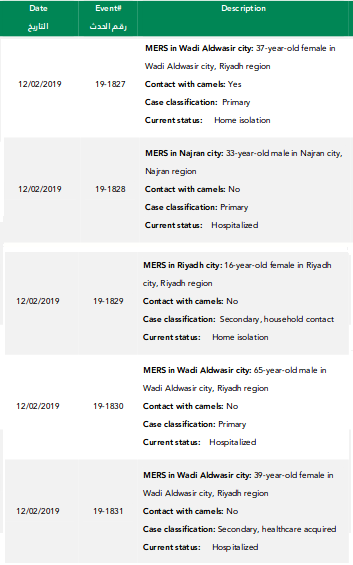 |
| Original Map Credit Wikipedia |
#13,858
Saudi Arabia's MERS surge continues today with 9 more cases - 7 of which originate from the hard hit Wadi Aldwasir region - which has produced 37 cases in just over 2 weeks.
In addition to these 7 Wadi Aldwasir cases, the MOH reports a secondary, household contact case (16, F) in Riyadh and a primary (no camel contact) case (33, M) in Najran City.While there was a cluster of household contact cases reported in Riyadh in early January, this seems most likely - due to the 30 day gap - to be a new cluster; possibly related to the 66, M reported on February 7th.
So far, for 2019, Saudi Arabia has reported 57 MERS cases. While most of the action this month has been in Wadi Aldwasir, today's case from Riyadh is the 12th for the Saudi Capital since beginning of the year.Among the 7 Wadi Aldwasir cases announced today, only 2 are listed as secondary, Healthcare-acquired - 3 are listed as primary (2 with camel contact, 1 without) - and 2 are listed as `Under Investigation', but without camel contact.
The Wadi Aldwasir outbreak, which began in late January, currently consists of:
- 3 Primary, community acquired cases without camel contact
- 5 Primary, community acquired cases with camel contact
- 6 cases have been listed as secondary, household contacts
- 2 cases have been listed as secondary, community-acquired
- 19 cases have been listed as secondary, healthcare-acquired.
- 2 cases are listed as `Under Investigation' but without camel contact
Today's list:
Yesterday the Saudi MOH tried to lay the blame for this outbreak on the Camel birthing season (see Crofsblog Saudi Arabia: MERS outbreak blamed on camels' birth season), and there is undoubtedly some truth to this.
MERS is continually reintroduced into the human population by infected camels in the region, and that happens more often this time of year (winter/early spring).But of the 37 cases reported from Wadi Aldwasir, only 5 (14%) are listed as primary, camel contact. And of those, we only make the assumption that is how they were all infected. It's a pretty good bet, but not a sure thing.
For 27 cases in this cluster, infection has been attributed to contact with an infected person, while for 5 cases, the source of infection has yet to be determined.We've seen clusters of MERS cases before - particularly healthcare settings - although in recent years their number and size has dropped as the Saudis implemented better infection control protocols.
Community transmission of the virus has thankfully been both sporadic and limited, and so the virus has fallen short of producing a sustained epidemic. Hopefully that will remain the case.
But a 2017 study found the virus's basic reproduction number (R0 : pronounced R-nought) was inching closer to the magic number of 1.0, which is what is required for an outbreak to have `legs' (see A Pandemic Risk Assessment Of MERS-CoV In Saudi Arabia).Which is one of the reasons why less than a year ago, in the WHO List Of Blueprint Priority Diseases, we saw MERS-CoV listed among the 8 disease threat in need of urgent accelerated research and development.
List of Blueprint priority diseases
(SNIP)
The second annual review occurred 6-7 February, 2018. Experts consider that given their potential to cause a public health emergency and the absence of efficacious drugs and/or vaccines, there is an urgent need for accelerated research and development for*:
- Crimean-Congo haemorrhagic fever (CCHF)
- Ebola virus disease and Marburg virus disease
- Lassa fever
- Middle East respiratory syndrome coronavirus (MERS-CoV) and Severe Acute Respiratory Syndrome (SARS)
- Nipah and henipaviral diseases
- Rift Valley fever (RVF)
- Zika
- Disease X


